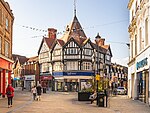Xplore!
2003 establishments in Wales2020 establishments in WalesEducation in Wrexham County BoroughMuseums established in 2003Museums established in 2020 ... and 5 more
Museums in Wrexham County BoroughScience education in WalesScience museums in WalesUse British English from August 2022Wrexham
Xplore! Science Discovery Centre, branded simply as Xplore!, is a science centre in Wrexham, Wales. It is currently based between Henblas Street and Chester Street in Wrexham city centre. Formerly known as Techniquest@NEWI and Techniquest Glyndŵr, as a sister venue to Cardiff's Techniquest, it was housed on Wrexham University's (then Glyndŵr University) Plas Coch campus from 2003 until its relocation in 2020. The centre is operated by North Wales Science, a charity wholly owned by Wrexham University.
Excerpt from the Wikipedia article Xplore! (License: CC BY-SA 3.0, Authors).Xplore!
Henblas Street, Wrexham City Centre
Geographical coordinates (GPS) Address Nearby Places Show on map
Geographical coordinates (GPS)
| Latitude | Longitude |
|---|---|
| N 53.04639 ° | E -2.99191 ° |
Address
Xplore! Science Discovery Centre
Henblas Street
LL13 8BD Wrexham, City Centre
Wales, United Kingdom
Open on Google Maps











